Dachshund Dew Claws – What You Need to Know
Dew claw removal was once a common practice in the United States.
But, as we learn more about the purpose of the dew claw and how it is used in their daily lives, many veterinarians are choosing not to perform this procedure unless there is an injury.
But what is a dew claw and what role does it play in your Dachshund’s regular routine?
What Are Dew Claws?
A dog’s dew claw is the fifth digit on a dog’s paws similar to a thumb or big toe.
It sits slightly higher than the rest of your dog’s toes on the inside of the leg.
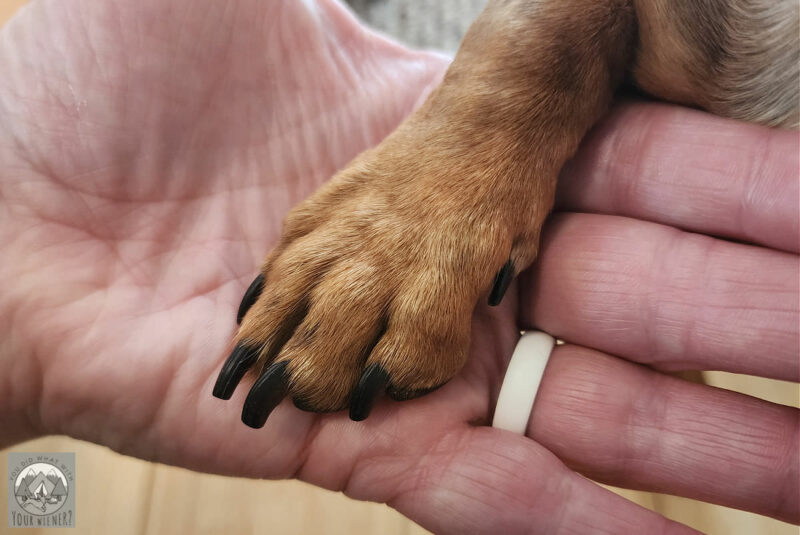
At first glance, most dog owners notice only the claw. But, if you look closer, you will notice that there is an actual digit, or toe, as well.
A dog’s dew claw can be either attached or detached.
An attached dew claw has a bone in it, allowing it to fuse and attach to the bones in your dog’s paw.
A detached dew claw does not have a bone. These dew claws are often only attached by skin and are easier to remove but are also more prone to injuries.
Unlike the other toes, the dew claw doesn’t bear any weight when your dog is standing, which leaves many dog owners wondering: What are dew claws? What is a dew claw for? Do they serve any purpose for your dog?
In the past, it was believed that the dew claw had no actual purpose.
However, as we learned more about dogs and how their bodies work, scientists and veterinarians have discovered that dogs can use their dew claws in several ways in their daily lives including for balance and traction.
Do Dachshunds Have Dew Claws?
Like most dogs, Dachshunds are usually born with dew claws.
If you’ve never seen a Dachshund that still has their dew claws, this may come as a surprise.
Which paws have a dew claw?
Dachshunds are almost always born with front dew claws. Rear dew claws are rare.
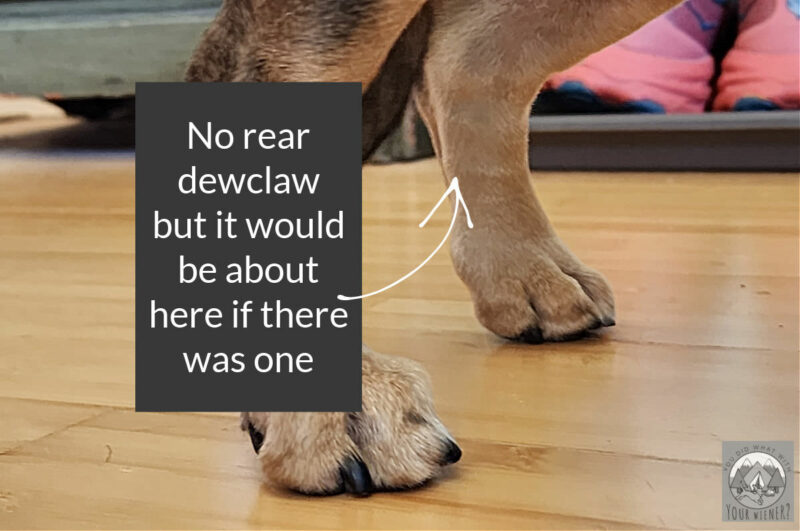
In the cases where rear dew claws are present, they are considered an anomaly.
These rear dew claws are almost always removed shortly after birth both for the breed standard and to prevent future injuries.
Why Do Dogs Have Dew Claws?
This “extra” claw may not look like much, sitting on the inner part of your dog’s paws. But your Dachshund’s dew claws provide many benefits.
The location of the dew claw serves an important purpose by stabilizing your dog’s wrist.
This helps to strengthen and support the wrist when your dog is running or walking, preventing unwanted injuries.
It also helps your dog balance and provides traction when moving across a variety of different surfaces, allowing them to move faster and more confidently.
The dew claw can also help to grip onto ice or the shoreline if a dog falls into the water and needs to climb free. This is especially common in colder climates.
They can also help your dog climb a steep or uneven hillside or slope (so they can be helpful if your Dachshund hikes like mine do).
If your dog is holding toys or chews, the front dew claws work like a human thumb. They can be used to hold the toy or chew in place.
Why Do Some Dachshunds Have Dew Claws and Others Don’t?
If dew claws are so common, you may be wondering why your Dachshund doesn’t have them.
It is possible that your dog was born without dew claws, but that is rare.
It is most likely that your dog’s dew claws were removed at a young age.
The removal of a puppy’s dew claws by the breeder is a common practice, especially in hunting breeds.
These breeds were bred to navigate brush and rough terrain where they are at risk of dew claw injuries.
Why Remove Dew Claws?
Dew claw removal has become a more controversial topic in recent years. This is because many see the removal of the dew claws as unnecessary and purely cosmetic.
When deciding whether to remove your Dachshund’s dew claws, you will need to look at the potential risks and benefits.
You will also want to consider how late you can remove dew claws – when is too late? As your dog ages, the procedure does become more complicated.
Pros of Removing Dew Claws
The most important reason for removing dew claws is the risk of injury.
The location and shape of the dew claw often cause it to become snagged in furniture, carpet, bedding, and other environmental hazards.
When this happens, it can lead to dislocation, a broken dew claw nail, or even the dew claw being torn off. These injuries are incredibly painful for your dog.
Removing the dew claw can also help with maintaining healthy feet.
Dew claws are positioned higher up the dog’s leg than the rest of their nails and lay flat against the leg.
This means that they do not wear down when you take your Dachshund for a walk.
They can be easily missed when trimming your dog’s nails or difficult to cut due to the angle.
If left to grow too long, a dew claw can curl around on itself, growing into the paw pad and causing significant pain.
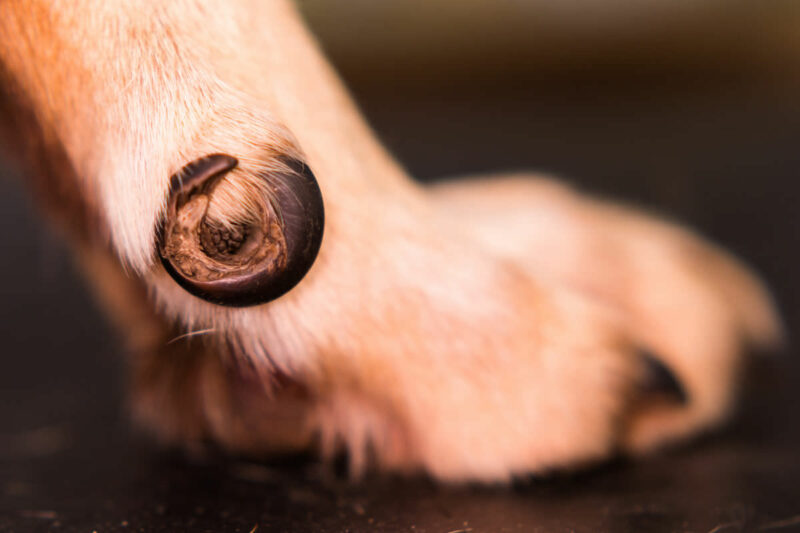
Cons of Removing Dew Claws
The front dew claw has five tendons and plays an important role in many activities including stabilizing the wrist when a dog is running or hiking.
Removing the dew claw means removing this benefit.
This is why dogs that are in sports like agility often keep their front dew claw.
There is also evidence that indicates dogs that have their front dew claws removed have a higher risk of developing arthritis later in life.
It can also cause problems in your Dachshund’s legs and body from trying to compensate for the weakness in the wrist.
If you are removing your dog’s dew claws later in life, there could also be complications from the surgery.
Some dogs develop problems with anesthesia as they get older. An unnecessary surgery would then create unnecessary risk.
Dew Claw Removal Cost
There are several factors that can influence the cost of removing dew claws. This includes which paws have a dew claw and whether they are attached or detached.
Most puppies that are born with dewclaws will have them removed just days after their birth.
This is the cheapest time to have the procedure done at a cost of only $10 to $35 per puppy.
It’s also preferred because it is a simpler procedure at this age and the puppy is too young to remember it.
As your dog gets older, the dew claw will connect and fuse to the bone, making the removal more complex.
The procedure is more complex and can run at a significantly higher cost.
The price can vary significantly depending on your dog’s age, how the veterinarian does the removal and the cost of veterinary care in your area.
The dew claw removal cost on an adult dog using a laser can cost $500 to $850 or more.
Can You Remove a Dew Claw at Home?
Given the costs associated with dew claw removal, many dog owners may be wondering how to remove dew claws at home, or if it’s even possible.
Is this a procedure that needs to be carried out by a veterinarian?
When puppies are born and the dew claw hasn’t yet fused to the bone, some breeders will remove it using scissors or nail clippers.
Unfortunately, in some cases, there will be regrowth of the nail.
When the dew claw is removed by a veterinarian, it can be done as newborn puppies under local anesthesia or later while they are under anesthetic for their spay or neuter surgeries.
This is a more thorough removal done with a scalpel, allowing the veterinarian to remove all the bones and prevent the nail from growing back.
As your dog grows up and the dew claw does fuse to the bone, it should only be removed by a veterinarian.
How to Care for a Dog’s Dew Claw
Many dogs will keep their dew claws without any serious injuries or problems during their lives.
All my Dachshunds have had front dew claws and, in the 15 years that I have been hiking with them, we have never had a dew claw injury or issue.
But, as dog owners, we need to understand how to maintain the dew claws and take care of an injury, if needed.
Trimming the Dew Claw
One way that you can prevent potential dew claw injuries in your dog is to focus on proper maintenance.
This means trimming the dewclaw when you are clipping your Dachshund’s nails.
Much like cutting the rest of your dog’s nails, you want to avoid cutting the dew claw back too far as it can cause pain and bleeding.
If your dog’s dew claw is overgrown, the quick may also have grown out longer. You will need to slowly trim back the dew claw allowing the quick to recede.
Trim the nail back as far as you are comfortable doing using a pair of nail clippers.
I find that the scissor style nail clippers make it easier to angle the tool as needed for the dew claw.
You could also use a nail grinder to file off the end if you prefer.
Each time you trim your dog’s nails, you will be able to cut the dewclaw back a little further until you reach the desired length that you want to keep it.
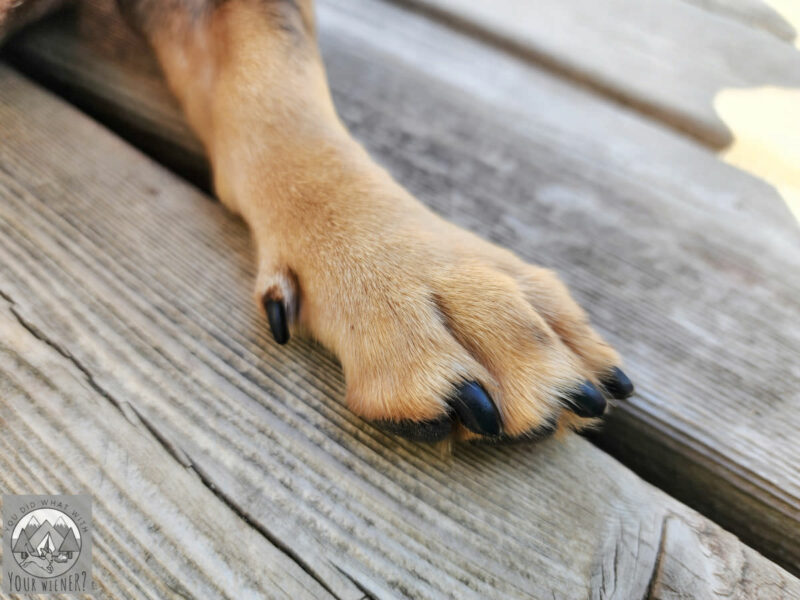
How to Care for a Broken Dew Claw, Quick Exposed
If your dog does break their dew claw, you should take care of it as soon as possible because these injuries can quickly get worse or get infected.
The quick of a dog’s nail may be small, but it can bleed a lot.
The priority is to try to stop the bleeding.
The best way to do this is by using some kind of styptic powder for dogs or blood clotting powder.
In a pinch, I’ve heard that household cornstarch can work too.
Wet your fingertip with water and dip it into the package clotting powder so that it is coated.
Then, place your fingertip against the bleeding nail tip with slight pressure, holding it in place for at least 10 seconds.
You may need to repeat this process more than once to get the bleeding to stop.
After you are sure the bleeding has been controlled, you can bandage the foot using a clean gauze held in place by Vet Wrap Tape Adhesive Bandage.
Be careful not to wrap the bandage too tight as it can cut off circulation to the paw.
Then make an appointment with your veterinarian.
Your veterinarian can remove the damaged part of the nail without causing too much pain for your dog, although they may need to use sedation or a nerve block to do so.
Your vet may also prescribe an antibiotic to prevent infection as the nail heals.
How to Care for a Broken Dew Claw, Not Bleeding
A broken dew claw that isn’t bleeding is less of an urgent situation, but it still should be taken care of as soon as possible.
Even a small crack in the nail can spread and become a much larger problem if it’s ignored.
If the break is at the tip of the nail without reaching the quick, cut back the nail to remove the broken part entirely.
If the break extends back close to or alongside the quick, you need to bring your Dachshund to the vet to take care of it.
How to Tell if a Dew Claw is Dislocated
It can be hard to identify a dislocated dew claw.
This can be a very painful and uncomfortable injury.
Not only can a dew claw be attached to the bones in your dog’s paw, but it can also be connected to the muscles.
The most common signs of a dislocated dew claw include:
- Bleeding around the dew claw
- Limping or reluctance to put weight on one paw
- Swelling around the dew claw or paw
- Whining, pacing, or other signs of discomfort
- Biting or licking the foot, especially around the area of the dew claw
If you notice any of these signs, contact your veterinarian.
Just like a broken dew claw, a dislocation puts your dog at risk of an infection or other complications.
Even if there is no visible bleeding, you may want to wrap the paw to stop your dog from being able to bite or lick, irritating the area.
Final Thoughts
Most Dachshunds are born with dew claws on the front feet but it’s rare for them to be born with them on the back, although it does happen.
If a Dachshund is born with a rear dew claw, it is almost always removed soon after they are born.
The front dew claws are rarely removed.
Even though it may appear as a useless digit, the dew claw does have a purpose, including aiding with traction and providing support for the ankle.
Dew claws are more prone to injury than the primary dog nails though so some owners opt to have them removed.
If you are considering having your Dachshund’s dew claw removed, weigh the pros and cons and don’t try to remove it at home (unless you are a breeder and have been trained to do it properly).
If your Dachshund has dew claws, understand that they grow and need to be maintained just like any other nail.
If your Dachshund walks on a hard surface so much that their primary nails wear down on their own and don’t need to be cut, don’t forget to regularly check the dew claw anyway.
Because of its position on the leg, it’s very rare that the dew claw will wear down in the same way. That means it’s prone to growing to0 long and curling under to dig into your dog’s foot or leg.
By maintaining your Dachshund’s dew claws, you can prevent many injuries.
If you do notice that something appears “off”, contact your veterinarian to take care of it quickly and prevent infection.
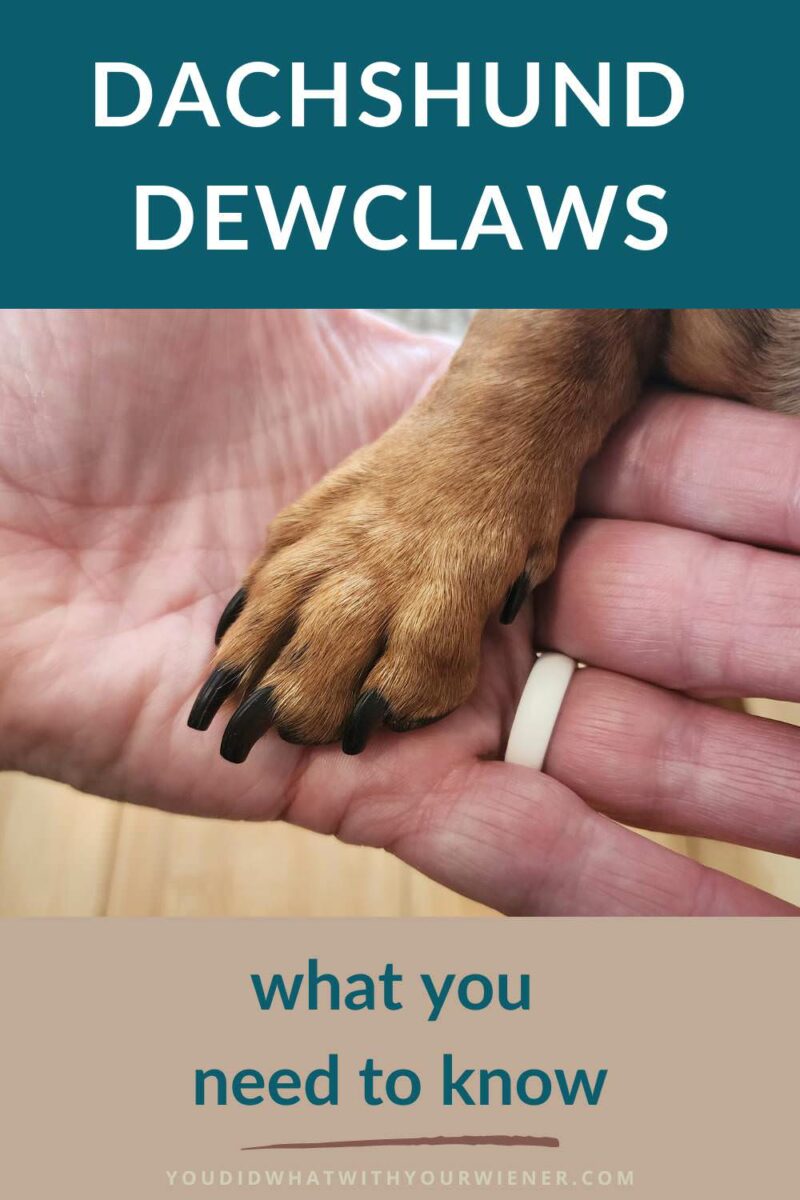

About the Author
Hi, I’m Jessica. I’ve been studying the Dachshund breed since 2007, owned 3 of my own, and shared in the lives of thousands of others through their owner’s stories. When I’m not sharing what I know on this blog, you can find me hiking, camping, and traveling with my adventurous wiener dogs.
